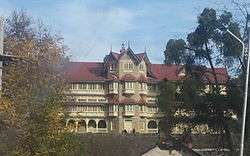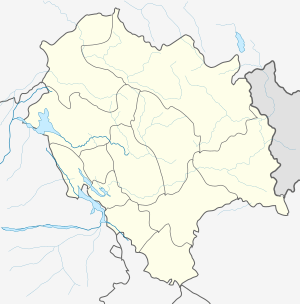Jubbal
Jubbal is a town and a nagar panchayat[2] in Shimla district in the Indian state of Himachal Pradesh.
Jubbal | |
|---|---|
Town | |
 Jubbal Palace, which was once the abode of the royal Jubbal family has been turned into a heritage spot now. | |
 Jubbal Location in Himachal Pradesh, India  Jubbal Jubbal (India) | |
| Coordinates: 31.1094667°N 77.6629967°E | |
| Country | |
| State | Himachal Pradesh |
| District | Shimla |
| Elevation | 1,901 m (6,237 ft) |
| Population (2011) | |
| • Total | 1,640[1] |
| Languages | |
| • Official | Hindi |
| Time zone | UTC+5:30 (IST) |
Geography
Jubbal, located at 31.1094667°N 77.6629967°E[3] has an average elevation of 2200 metres (7220 feet). A small hill town, it is famous for its apple orchards and the Jubbal Palace. Jubbal has a combination of vast landscapes, thick woods, and buildings. It is located at an elevation of 1901 meters.
History
The history of Jubbal State goes back to 12th century. Among the 18 thakuries located in the valleys of Sutlej, Pabbar and Giri this thakurrai was of considerable importance. Rulers of Jubbal belong to the Rathore clan. During 12th century The ugar chand The Raja of Sirmoor State, had a summer palace in Soonpur, The modern Hatkoti, which is overlooked by the plateau of Sonnpur, on the right bank of the pabbar river. While he was having pleasant company with his family he had to go back to Sirmaur leaving royal family behind. Due to heavy rainfall river giri got flooded and capital of the state was swept away and the royal family lost its ancestral possessions the Sirmur State forever to a prince of Jaisalmer.
The princely state of Jubbal was founded in 1800. It was occupied by Nepal from 1803 to 1815 and by the British from 1832 to 1840. The rulers who belonged to the Rathore clan took the title of Rana. The last ruler Rana Baghat Chandra took the title of Raja in 1918.
Jubbal State had an area of 288 square miles and was famous for its dense forests of 'deodar' trees. Today, Jubbal is reputed for its apple orchards which provide its residents their main source of income. The town of Jubbal is about 100 kilometres from Shimla.
Jubbal has also given the state of Himachal Pradesh a Chief Minister. Ram Lal Thakur of Barthata village who was the Chief Minister[4] from 1975 to 1977 and again from 1980 to 1982. The town is also home to the famous bollywood actress Priety Zinta.
Rulers of Jubbal State
The rulers of the princely state of Jubbal were: [5]
- 1803 - Purana Chandra
- 1803 - 1815 Occupied by Nepal
- 1815 - 1832 Purana Chandra
- 1840 - Purana Chandra (3rd time)
- 1840 - 1877 Rubin Kazan Chandra
- 1877 - 1898 Padma Chandra (b. ... - d. 1898)
- 1898 - 29 Apr 1910 Gyan Chandra (b. ... - d. 1910)
Demographics
The native language here is Pahari but Hindi and English are also spoken.
Climate
Jubbal shows wide and sweeping variations in its landscape, ranging from lush green and thick woods to dry lands bereft of vegetation. The valley is also famous for its apple orchards. The region is generally cool throughout the year with temperatures ranging from 15 degrees to 30 °C during the summer and falling below zero degrees during the winter. The winters are especially harsh and snowfall is frequent.
Tourism
Jubbal is a land of huge mansions and imposing citadels, with glittering streams, sparkling lakes and skillfully constructed temples adding to its glory. It is also an ideal spot for trekking due to its largely mountainous landscape, and angling opportunities are great due to the well endowed streams running through it. Jubbal is also a land of fairs and festivals, with the locals bursting into celebration at every conceivable opportunity. All these characteristics give Jubbal an elite and royal feel that can not be found elsewhere in the state.Places like Jubbal, far removed from the usual humdrum of the tourist crowd, are hard to come by.
Places to visit include the Jubbal Palace,[6] the Hateshwari mata temple,Chunjar peek,apple lodges of Badhal,Chhajpur,Nandpur region and Mahasu devta temple Hanol of Tiuni which is just 38 Km from Jubaal town. The Jubbal Palace is a hallmark of excellent craftsmanship, famous for its splendid architecture and its elaborately exquisite citadel. A part of the palace, called the Rana’s abode, is built in Chinese style with suspended attics and structures carved out of deodar timber. The modern wing of the palace has an Indo-European design and feel with convoluted wooden ceilings and the works. This palace which was once the abode of the royal Jubbal family has been turned into a heritage spot now. An entire day can be spent admiring this exquisite and imposing mansion.
The Hateshwari temple, is a beautiful two storied pagoda style structure believed to have been built by the Pandavas. Constructed around 800-1000 AD, the temple was renovated by the Jubbal rulers in the 19th century; the main idol of Hatkeshwari and the inner sanctum sanctorum were barely affected though. The place looks truly ethereal and out of this world during the evening prayer hours, when the fumes and sounds of the evening aarthi reverberate through its premises
Getting there
Traveling to Jubbal by road is the most preferred mode, because many state owned buses ply from Shimla to Jubbal. Buses and cabs are available for travel within the city. Private vehicles are also available from Shimla to Jubbal for moderate prices around 1000-2000 INR. The nearest narrow gauge railway line is at Shimla again, which is connected to Delhi by train. Jubbar Hatti airport provides irregular services, mainly due to fluctuating weather. You can obtain a more reliable service at Shimla airport which has direct flights to New Delhi.
References
- "Census India". Archived from the original on 14 May 2007. Retrieved 10 March 2013.
- "List of Municipalities / Urban Local Bodies in Himachal Pradesh". Archived from the original on 2 August 2013. Retrieved 2 December 2013.
- Falling Rain Genomics, Inc - Jubbal
- "Himachal Pradesh Legislative Assembly". Legislative Bodies in India website. Archived from the original on 1 March 2012. Retrieved 10 January 2010.
- Rulers
- "HP Tourism Development Corporation Ltd". Archived from the original on 19 July 2013. Retrieved 21 June 2013.